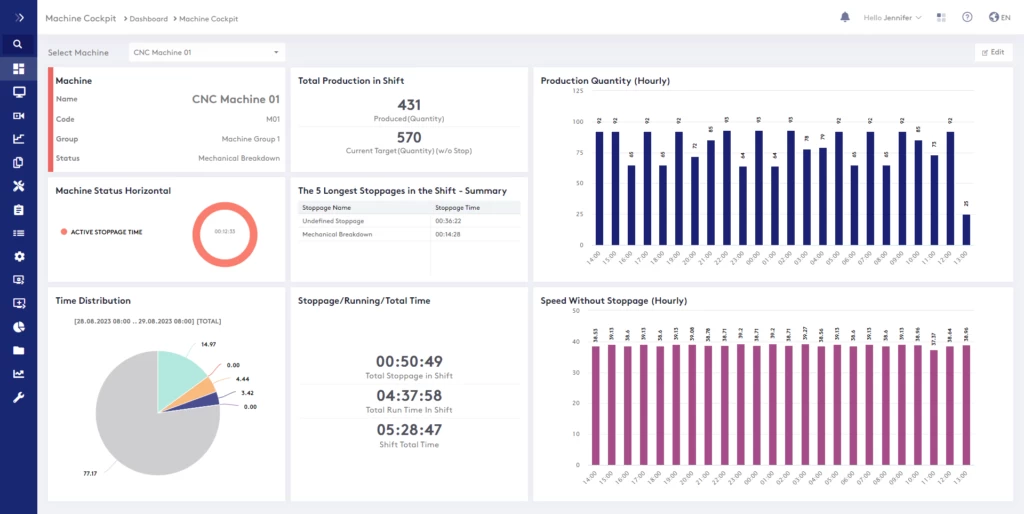A production monitoring system (PMS) is a real-time digital tool that optimizes manufacturing efficiency by tracking performance metrics, reducing downtime, improving quality control, and enabling data-driven decision-making in the industry.
—
Originally posted on: https://promanagecloud.com/what-is-a-production-monitoring-system/
What is a Production Monitoring System?
We live in a fast-paced business world, where staying competitive means not only having a great product but also making sure it’s produced efficiently and to the highest quality. To achieve that, there’s a game-changing tool that savvy businesses are using to keep their production lines humming smoothly, minimize disruptions, and get the most out of every work hour. We’re talking about production monitoring system. This behind-the-scenes hero works tirelessly, leveraging the latest technology and smart analytics to give businesses a clear window into their operations. So for companies looking to stay ahead, embracing a production monitoring system is not just smart; it’s essential for thriving (and surviving) in today’s complex and ever-changing market landscape.
Let’s dive deeper into understanding everything you need to know about a production monitoring system.
Everything You Need To Know About CNC Data Collection
Firstly, What is a Production Monitoring System (PMS)?
Production monitoring has evolved into a sophisticated, real-time digital ecosystem that offers a panoramic view of the manufacturing process. At its core, a real-time production monitoring system is an advanced suite of digital tools designed to keep a constant watch over the various facets of a production line.
This innovative approach surpasses traditional data logging by providing instantaneous feedback on machine performance, process efficiency, and overall production output. It’s a method that enables manufacturers to gain an in-depth understanding of their operations, allowing for immediate identification and resolution of any issues that arise.
Gone are the days when companies relied solely on designated employees to oversee production lines—a practice that, while effective to a degree, offered only a snapshot of the broader production landscape at any given moment. Today’s production monitoring systems offer a dynamic, comprehensive solution, ensuring not just the quality of products but also enhancing operational efficiency and productivity across the board.
 A good production monitoring system reduces waste and losses.
A good production monitoring system reduces waste and losses.
Understanding How a Production Monitoring System Works?
Choosing the right tools for optimizing your manufacturing processes is crucial and we’re here to help.
So, a PMS is a sophisticated software solution designed to track and analyze the manufacturing process as it unfolds. It’s engineered to collect, process, and display data from every step of production. By offering real-time insights into vital performance indicators such as production volume, production quality, machine efficiency, machine downtime with pareto analysis, scrap ratio with pareto analysis and it highlights areas ripe for improvement.
In the dynamic world of manufacturing, where meeting production targets and upholding stringent quality standards are non-negotiable, a PMS proves indispensable. It integrates flawlessly with both the machinery on the production floor and the broader network of systems, including programmable logic controllers (PLCs) and enterprise resource planning (ERP) software. This seamless integration allows for a continuous flow of data directly from the source, ensuring that manufacturers have the latest information at their fingertips. Such immediate access to data empowers manufacturers to make swift, informed decisions aimed at enhancing production efficiency and curtailing the risk of expensive operational halts.
How Do You Choose The Best MES Software?
Moreover, a PMS is not just about monitoring; it’s about transforming data into actionable intelligence. It facilitates a proactive approach to maintenance, predicting potential machine failures before they occur, and recommending preventive measures. This proactive maintenance can significantly extend the lifespan of machinery, optimize production schedules, and save costs associated with unplanned downtime. Furthermore, by continuously analyzing production data, a PMS can identify patterns and trends, enabling manufacturers to anticipate demand changes and adjust production accordingly. This level of agility is critical in today’s fast-paced market, where consumer preferences and demands can shift rapidly. Ultimately, a production monitoring system is a powerful ally in the quest for manufacturing excellence, driving productivity, enhancing quality, and ensuring a competitive edge in the market.
 Production monitoring system implemented in factories.
Production monitoring system implemented in factories.
Benefits of a Real-Time Production Monitoring System
Implementing a real-time production monitoring system offers a multitude of benefits that can significantly enhance the efficiency and quality of manufacturing operations. Let’s discuss key advantages that make real-time production monitoring an invaluable asset for any manufacturing entity.
- Enhanced Efficiency
Real-time production data is a game-changer for identifying and addressing bottlenecks and inefficiencies within the production line. Managers gain the ability to swiftly pinpoint areas that hinder productivity, enabling quick adjustments that lead to smoother operations and a noticeable increase in output. This level of oversight ensures that every part of the manufacturing process is aligned for optimal performance.
- Reduced Downtime
The immediate flagging of issues, such as equipment failures or material shortages, allows for swift interventions. Implementing proactive maintenance based on real-time alerts not only prevents unexpected downtime but also keeps machines operating at their best. This proactive approach translates into considerable cost savings and enhanced operational reliability.
- Improved Quality Control
With real-time monitoring, maintaining high production quality becomes more manageable. It enables the detection of deviations from quality standards as they happen, facilitating prompt corrections. This proactive quality management minimizes the risk of producing defective items, ensuring a consistent and high-quality output that meets customer expectations.
- Data-Driven Decision Making
Access to real-time production data fosters a culture of informed decision-making. Managers can leverage this data to analyze trends, adjust resource allocation, and refine production schedules. This informed approach optimizes resources, enhances production planning, and can significantly improve the bottom line.
The Importance of Production Monitoring in Manufacturing
Enhancing Visibility and Control
One of the primary benefits of production monitoring is the enhanced visibility it provides into the manufacturing process. By capturing real-time data from machines, sensors, and production lines, these systems offer a comprehensive view of the entire operation. Manufacturers can now monitor key performance indicators (KPIs) such as production output, quality metrics, and machine utilization in real-time, enabling them to identify issues and address them promptly.
This level of visibility also empowers manufacturers to take control of their operations. With the ability to track and analyze every stage of the production process, they can make data-driven decisions, optimize resource allocation, and implement targeted improvements to drive efficiency.
Driving Continuous Improvement
Production monitoring systems are not merely passive data collectors; they are powerful tools for driving continuous improvement. By providing detailed insights into the manufacturing process, these systems enable manufacturers to identify areas of waste, inefficiency, and quality issues. Armed with this information, they can implement lean manufacturing principles, streamline workflows, and continuously refine their processes to enhance productivity and profitability.
Moreover, the real-time nature of production monitoring allows for proactive problem-solving. Manufacturers can quickly detect and address issues before they escalate, minimizing downtime, reducing scrap, and improving overall equipment effectiveness (OEE).
Enhancing Collaboration and Decision-Making
Production monitoring systems act as a central hub for manufacturing data, fostering collaboration and informed decision-making across the organization. By integrating these systems with enterprise resource planning (ERP) and other business systems, manufacturers can ensure seamless data flow and break down silos between departments.
This integrated approach empowers managers, operators, and quality teams to access the same real-time information, enabling them to make collective, data-driven decisions. This collaborative environment not only improves operational efficiency but also enhances cross-functional communication and problem-solving.
Contact Info:
Name: iCopify
Email: Send Email
Organization: icopify
Website: https://icopify.co/
Release ID: 89135260
If there are any errors, inconsistencies, or queries arising from the content contained within this press release that require attention or if you need assistance with a press release takedown, we kindly request that you inform us immediately by contacting error@releasecontact.com (it is important to note that this email is the authorized channel for such matters, sending multiple emails to multiple addresses does not necessarily help expedite your request). Our reliable team will be available to promptly respond within 8 hours, taking proactive measures to rectify any identified issues or providing guidance on the removal process. Ensuring accurate and dependable information is our top priority.






